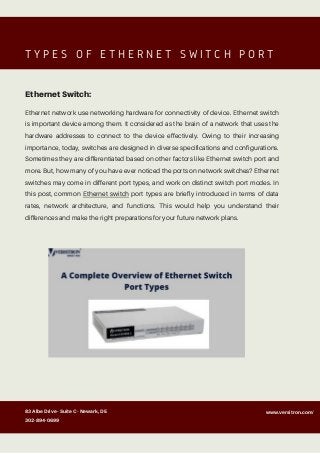
Types of ethernet switch port.pdf
- 1. Ethernet network use networking hardware for connectivity of device. Ethernet switch is important device among them. It considered as the brain of a network that uses the hardware addresses to connect to the device effectively. Owing to their increasing importance, today, switches are designed in diverse specifications and configurations. Sometimes they are differentiated based on other factors like Ethernet switch port and more. But, how many of you have ever noticed the ports on network switches? Ethernet switches may come in different port types, and work on distinct switch port modes. In this post, common Ethernet switch port types are briefly introduced in terms of data rates, network architecture, and functions. This would help you understand their differences and make the right preparations for your future network plans. Ethernet Switch: 83 Albe Drive - Suite C - Newark, DE 302-894-0699 T Y P E S O F E T H E R N E T S W I T C H P O R T www.versitron.com/
- 2. RJ45 Port: RJ 45 is registered jack 45. It is quintessential Ethernet style data port found on switches, network cards, routers and more. This port on 100/1000BASE switch used in LANs, data centers for server switching, and uplinks from desktop switches for broadband application. A Ethernet cable such as CAT5 or CAT6 is required for connecting two RJ45 ports on Gigabit switches. SFP and SFP+ Port: The small form-factor pluggable or SFP port is designed for small form factor (SFF) connectors. It offers high speed and physical compactness. It enables a Gigabit switch to allow copper uplinks over long distances by inserting the corresponding SFP module. On the other side, SFP+ is an evaluation of SFP port and supports higher speeds up to 10Gbps. While comparing the compatibility of both ports, SFP+ often accepts SFP optics at a lower speed of 1Gbps. But, one can’t plug in SFP+ transceiver into an SFP port as it does not support speeds less than 1Gbps. SFP 28 Port: It is an evolution of the SFP+ port and provides a new way to upgrade network:10G-25G-100G. It has the same form factor as the SFP+ but provides 25Gbps over a single lane. QSFP28 Port: It is designed for 100g applications. It offers high-speed differential signals with data rates ranging from 25Gbps to 100Gbps. QSFP+ Port: It is an enhanced version of the quad small form-factor pluggable or QSFP. It has four-channel Gbit/s SFP+ interfaces that offer a transfer rate up to 40Gbps. The data rate is one of the important factors for an Ethernet switch interface. It varies from 1G to 100G and beyond. Here is the list of mainstream interface types of these data rates. Ethernet Ports by Data Rates: 83 Albe Drive - Suite C - Newark, DE 302-894-0699 T Y P E S O F E T H E R N E T S W I T C H P O R T www.versitron.com/
- 3. PoE Port: The power over Ethernet or PoE switch port can transmit both data and power through a single cable. It delivers power in two standard formats – IEEE 802.af (delivers power up to 15.4 on an Ethernet switch port) and IEEE 802.3at (delivers power up to 30 watts on an Ethernet switch port). Combo Port: It is a compound port which supports dual front ends such as an RJ45 and SFP connector. However, these different ports can’t be used simultaneously. That means RJ45 port is being used, the corresponding port is automatically disabled and vice versa. One best advantage is that it provides different connectivity without taking up unused switch fabric, allowing users the power and flexibility to configure their switch as required. Stack Port: It is a special functional port on the switch. It is used to connect other stackable network switches of the same model to operate as a single stackable switch. It can be an uplink port; however, some network switches may have a dedicated port for stacking. It is one economical solution with great flexibility and preferred for long-distance connections. Like data rates, functions and applications are vital for Ethernet switch connector types because the same port is used for various purposes. This helps us gain insights into Ethernet switch port types configurations. Ethernet Ports by Functions: 83 Albe Drive - Suite C - Newark, DE 302-894-0699 T Y P E S O F E T H E R N E T S W I T C H P O R T www.versitron.com/
- 4. Access Port: As its name implies, it is used for connecting devices available in access links such as laptops, desktops, printers, and more. An access port can only be a member of specific VLAN, and it sends as well as receives regular Ethernet frames in untagged form. Trunk Port: A trunk port is used between switches and higher-level network devices available in trunk link. It allows for several VLANs set up, thus, it can carry traffic for numerous VLANs at the same time. Hybrid Port: It can connect the user as well as network devices, thus named hybrid port. It supports both tagged VLAN like trunk port and untagged VLAN like access port, receiving data from one or more VLANs. Network architecture comprises three layers such as core layer, access layer, and distribution layer. Fortunately, network switches also have these types. Ethernet Ports by Network Architect: 83 Albe Drive - Suite C - Newark, DE 302-894-0699 T Y P E S O F E T H E R N E T S W I T C H P O R T www.versitron.com/